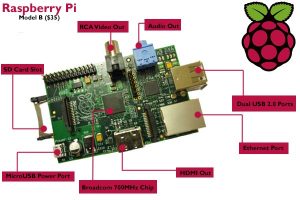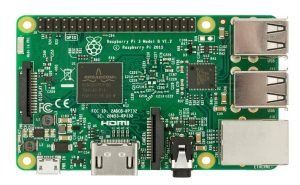It is a computer board with the size of a credit card, measuring approximately 9cm x5.5cm. Raspberry Pi operates on Fedora, Raspbian, and Debian. By default, it supports Python programming language. We can use Raspberry Pi for designing, experiments and innovations, there are two types of models Model A and Model B. The difference between them is a USB port, in a Model A the board does not have an ethernet port connection but a Model B contains ethernet port connection.

Raspberry Pi is an open source technology like communication and web technologies. In Raspberry Pi 3 we have, 4 USB ports, GPIO pins, Micro USB power, SD card slot, Ethernet port, DSI display connector, Audio and video port, HDMI port. We can connect to CPU for power supply, keyboard, and mouse. The board designed with 256MB of RAM in it. GPU(Graphics Processing units) used for speeding up the calculations. There 40 GPIO pins which consist of VCC and GRND. XBee used for a wireless communication system in Raspberry Pi. Raspberry Pi can only handle digital signals.
Components of Raspberry Pi:
ARM CPU/GPU: It is a Broadcom chip on the system that made up of ARM central processing unit and video graphics processing units. CPU takes all inputs and GPU handles all output.
GPIO: General purpose input and output.
HDMI: Allows to hook up a high definition television, or compatible devices using a cable.
Power: It has 5v USB power connector where power supply will take place through the compatible device.
SD card: In this card we install Raspberry Pi software and for booting the device.
LED: Light emitting diode, it is a light indicator.
RCA: Allows connection to TVs and other output devices.
Ethernet: This allows for network accessing and is only compatible with Model B.
Technical specifications:
• Broadcom BCM2837 Arm7Quad Core
• 1GB RAM
• 4 x 2 USB ports
• 4 stereo outputs and video sharing port
• Full-size HDMI
• Camera port used for connecting Raspberry camera
• DSI display port used for connecting the display
• SD port for loading the data and storing data.
• Micro-size USB with power source

Uses of Raspberry Pi:
• Desktop or Smart TV
• Gaming
• Building Smart water tanker
• Radio station
• Media
• Home automation system
• Pi phone
• Web server
• Cloud server
• Temperature sensing

Finally, we can build plenty of things with Raspberry Pi and can work on several projects, like creating amazing devices which are useful for our daily life. To know more about Raspberry Pi Technology visit this link.


















